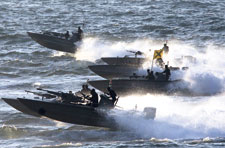Last week marked the 60th anniversary of the Sri Lanka Navy. It was on December 9, 1950 that the Navy Act was enacted and the Navy was formed. Originally known as Royal Ceylon Navy, the name was changed to Sri Lanka Navy in 1972 after the introduction of the new constitution.
Prior to Independence it was the British Navy ('Royal Navy' as it was called) that existed in Sri Lanka forming part of the British forces. The Ceylon Naval Volunteer Force (CNVF) had been established in 1937. It was absorbed into the Royal Navy in 1945 after World War II and was known as Ceylon Royal Naval Volunteer Reserve (CRNVR).
 |
| Arrow - boats in action |
The Navy played the role of 'Aid to Civil Power' and looked after the
security of the Port of Colombo after the World War II. With the
acquisition of 'Vijaya', anti-smuggling and
anti-illicit immigration patrols were carried out.
Until 1955, the heads (Captains) of the Navy were all officers on loan from the Royal Navy. They were Capt. W.E. Banks, Capt. J.R.S. Brown, Capt. (later Cmde.) P.M.B. Chavasse. The first Sri Lankan
officer to take over
command of the Navy was Capt. (later Rear Adm.) G.R. (Royce) M. de Mel who took over in 1955.
While operations were handled from Naval Headquarters in Colombo Fort a training base was established in Diyatalawa. Naval
shore-based camps were set up starting with one in Talaimannar, followed by one in Karainagar which functions as a key base in the North until now.
The need for small craft to patrol off-shore, particularly in the North was seen and gradually these were purchased. Among the craft acquired in the early stages were a seaward defence boat ('Kotiya'), long patrol boats ('Hansaya') & 'Lihiniya') and four short patrol boats ('Seruwa', 'Diyakawa', 'Tarawa' & 'Korawakka'). These were used to patrol the Palk Straits along with the
bigger vessel 'Vijaya'. Powers under the Customs Ordinance were devolved on Naval Officers for the purpose of checking illicit smuggling.
'Vijaya' was used for visits overseas as part of her duties as a training vessel. In 1951 'Vijaya' sailed to the Maldives with Transport & Works Minister Sir John Kotelawela followed by a second visit two years later when the Republic of Maldives was
proclaimed. In 1955, she took a Tri-Service Buddhist Delegation to Burma for the 'Chatta Sangayanaya', carrying a sapling from the Sri Maha Bodhi. Several Buddha Statues were received as gifts, two of which were enshrined in Nagadvipa Temple and at Tissa Viharaya in Trincomalee. 'Vijaya' also participated in JET (Joint Exercises, Trincomalee), an annual event from 1950 to 1962.
With the decision
by Prime Minister
S. W. R. D. Bandaranaike to abrogate the Defence Agreements and take over the British bases in
Sri Lanka in 1956, the Navy had to take over the large Base, 'HMS Highflyer' in Trincomalee, with the barest of resources. Prime Minister Bandaranaike announced this was the removal of a remnant of colonialism and one more step towards full freedom.
The Navy had to be expanded and provided with ships to protect our waters. Both were done. In 1958 the Navy had 48 officers and 510 sailors. The Navy expanded both in terms of manpower and vessels in the years that followed.
With the formation of the Democratic Socialist Republic of Sri Lanka in 1972, the Royal Ceylon Navy became the
Sri Lanka Navy. The Naval Ensign also shed the St. George's Cross as it had been done in all major ex-colonial navies, and Flag Officers' flags were redesigned. The term 'Captain of the Navy', introduced in the Navy Act, was changed to 'Commander of the Navy', in keeping with the
terminology adopted by the other two services. 'Her Majesty's Ceylon Ships' (H.M.Cy.S.) became 'Sri Lanka Navy Ships' (SLNS).
The expansion saw the first ships sailing in - the 'Shanghai' class Fast Gun Boats (FGB) SLNS 'Sooraya' and 'Weeraya' - gifts by the People's Republic of China. Much bigger than the patrol craft they carried a
battery of guns. Three more - 'Dakshaya', 'Ranakamee' & 'Balawatha'– were
purchased in 1973 and 'Jagatha' and 'Rakshaka' in 1980. Many more were added in recent years and today the fleet centres around a sea going force of more than fifty combat and support ships and inshore patrol craft.
The Sri Lanka Navy played a pivotal role during the 30-year war against terrorism. While the Sri Lanka Navy
personnel gallantly
performed their sacred duty towards the nation, many paid with their lives. Apart from many
battles fought at sea, the most significant contribution was the destruction of ten terrorist ships laden with warlike materials.
The Sri Lanka Navy is now described as a
well-balanced and
cohesive force, capable of operating in waters around Sri Lanka
effectively safeguarding our national interests. |


